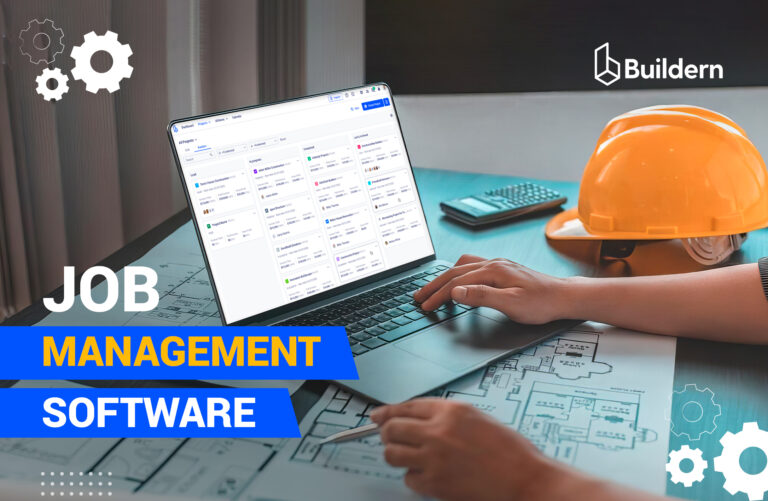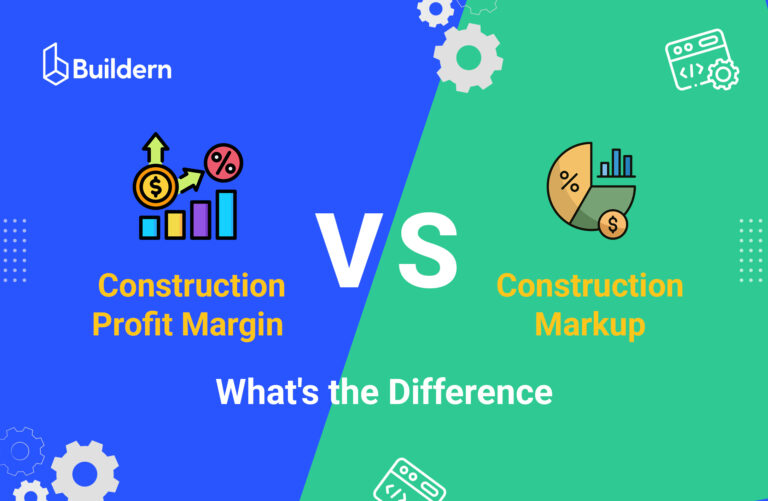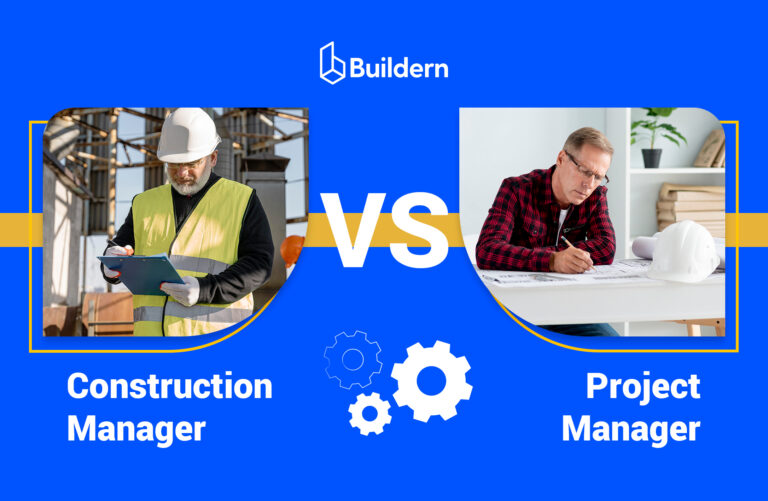Construction Invoicing: 5 Steps to Get Paid on Time In 2024
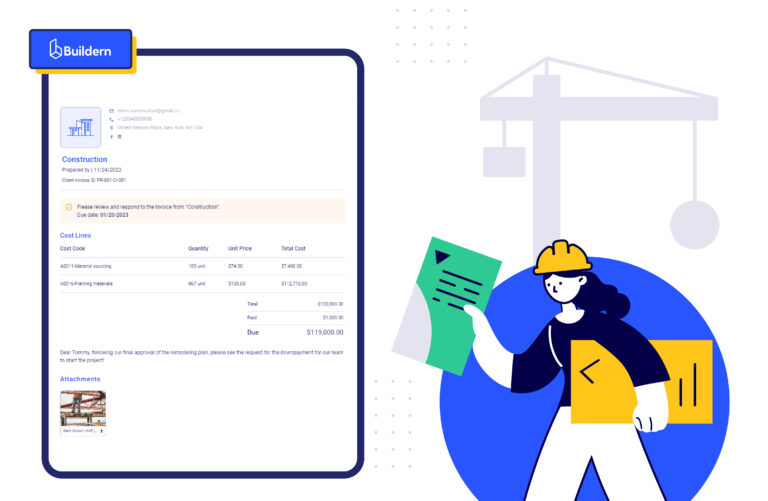
Last update February 2024
86% of construction professionals experience stress from slow payments and cash flow problems. This creates a chain reaction of financial hardship for the construction companies, resulting in reduced profits, project delays, etc.
But hold on; why should this be the case?
Getting your construction invoicing payments on time can be a challenge or a smooth process – all depending on how well you manage your invoicing strategy.
Everything matters when it comes to timely payments in construction projects. You must send invoices on time, follow up with your clients on time, use the right software, and manage payment terms effectively.
On the other side, accurate construction invoicing has many enemies. Managing multiple construction projects of different scopes and communication may result in gaps, making it challenging to keep track of the construction billing processes.
But no worries. When there is a problem, there is a solution.
Buildern, a community of construction industry explorers, has accumulated some of the best practices to help you make sure that your invoices are paid on time.
This guide will never ever leave you with overdue payments.
Scroll down and read on…
Table of Contents
- What Are Construction Invoices?
- What Should Be Included in the Construction Invoice?
- 5 Quick Steps of Construction Invoicing Process
- 8 Best Practices of Construction Invoicing to Get Paid on Time
- Invoicing Is Only the Top of the Iceberg
What Are Construction Invoices?
Construction invoices are detailed reports of the services and products a contractor supplies to its customer, which oblige the latter to pay the required amount by a certain date.
Invoices and payment applications are not the same. The payment application includes a bundle of documents that prove the release of payments. It’s used when the payment is already received, while invoices are sent to request the payment.
Invoices and purchase orders are not the same. Purchase orders are issued by the company to the subcontractor or vendor and include all details about the supplies, services or materials that need to be provided. Invoices are used for billing the customer after delivery has been completed.
What Should Be Included in the Construction Invoice?
Invoices can differ in format and details, depending on the size of the project and the payment terms agreed upon by the contractor and client.
However, some general information should be included in all invoices.
Unique Invoice Number
Having unique serial numbers for each invoice is a widely-accepted accounting approach that helps to track invoices and payments. For example, start with INV00001 and increment the number for each invoice. You will thank yourself later when you need to track invoices or when you need to recheck any invoice with the customer.
Date Issued and the Due Date
“Date Issued” is when the invoice is created and sent to the customer. “The Due Date” is set by you. It’s the deadline for the customer to pay the amount and it’s crucial to keep your customers updated about the payment terms. Without a due date, payments can be delayed and lead to cash flow problems.
Your Business Details
Business details include the company name, logo, address, contact information and any other formal information you want to have. Put the business details at the top of your invoice in a clear font so your customers can easily recognize it.
Client’s Business Details
Include the full name, address and contact information of your customer and make sure that it’s correct. Dig into details such as the department, contact person, etc., as this information will help you track down the payments or any other communications later.
Provided Service
This is the most crucial part of the invoice. List down the services you provided with a detailed description and the corresponding amount you are asking for. Also, include any taxes or additional costs associated with your service. Any misleading or incorrect information can cost you in the long run.
Invoice Amount
The total amount includes the additional taxes and fees associated with your service (if any) and should be clearly visible to the customer.
Retainage
If retainage is involved in the project, ensure to include it in the invoice. Retainage is a percentage of the total value that the customer withholds until all tasks are completed and accepted.
Payment Terms
Payment terms are the details about the payment methods, discounts or incentives (if any) you offer and the due date for the payment. Clearly mention which payment methods are acceptable to you (bank account, PayPal, Google Pay, etc.) and details for the client to transfer the money.
All these data should be organized in a neat and professional layout that is easy to read and understand.
Feels like a lot of hassle? Not with Buildern!
Scroll down for the user-friendly platform that makes creating and managing invoices a breeze!
5 Quick Steps of Construction Invoicing Process: Send Your First Invoice With Buildern
Here’s an example of the construction invoice you can create in Buildern. There is no need to deal with complex formatting to make your invoice look professional. Just fill in the details inside your invoicing dashboard and the software will arrange it in a neat layout according to the accepted industry standards.
Following are the quick steps to send your first invoice.
Step 1: Create the Project and Add the Client You Want to Invoice
To send an invoice with Buildern, you need to create the project you are working on and add the client’s data you want to invoice.
You can quickly sign up to Buildern with this link, fill in the basic project details and add the data of all the clients you will need to invoice during the project.
Step 2: Add the Invoice Amount
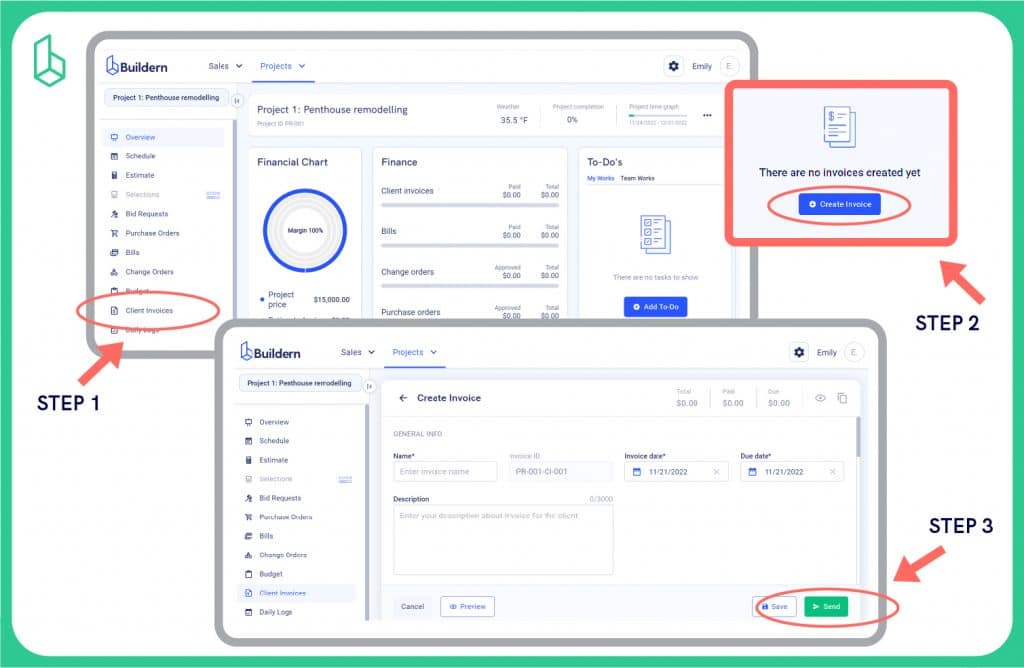
Once you click “Create a New Invoice“, a premade template will appear with all the information you need to fill in.
Buildern will automatically generate serial numbers for your invoices, making it easier for you to track down the payments and information related to them. However, you can name your invoice according to your preferences for more convenient internal tracking.
The “Description” part is optional to fill in. However, it is highly recommended to include the performance date and any other specific details related to your service there. Everything you fill in the “Description” field will be visible to the client.
Scrolling a bit down, you will see two options for cost items.
Option 1: Line Items – Informing Your Client on the Spent Resources in Every Detail
If you choose “Line Items“, the software will allow you to add unlimited items with the exact cost and specific details related to each of them. This way, you will be able to inform your client on the spent resources in every detail – how many people worked on the jobsite and what their salary was, which construction materials were used and how much they cost, etc.
Luckily for you, the software already includes the cost codes of the most popular construction materials and labor. Just choose the code that applies to your situation, and add any other specific details. Buildern will automatically calculate the total cost of this line item.
If you need to add a new cost code, do it with one click.
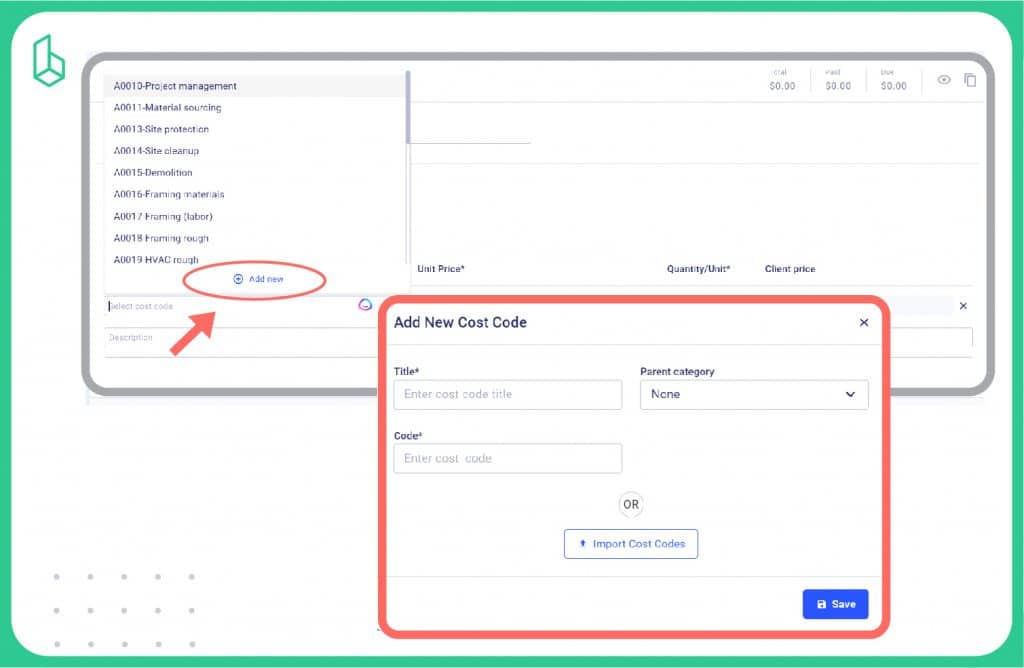
Once you’ve added all the resources spent on the job site, Buildern will calculate the total invoice amount visible to the client.
Option 2: Flat Rate – Not Going Into Every Detail With Your Client
If there is no requirement from the client to have a detailed report on the spent resources, you can choose the “Flat Rate” option.
In this case, you do not have to deal with all the details and calculations. Just enter the total invoice amount and an optional description. The client will see the invoiced sum without a detaield breakdown of the cost items.
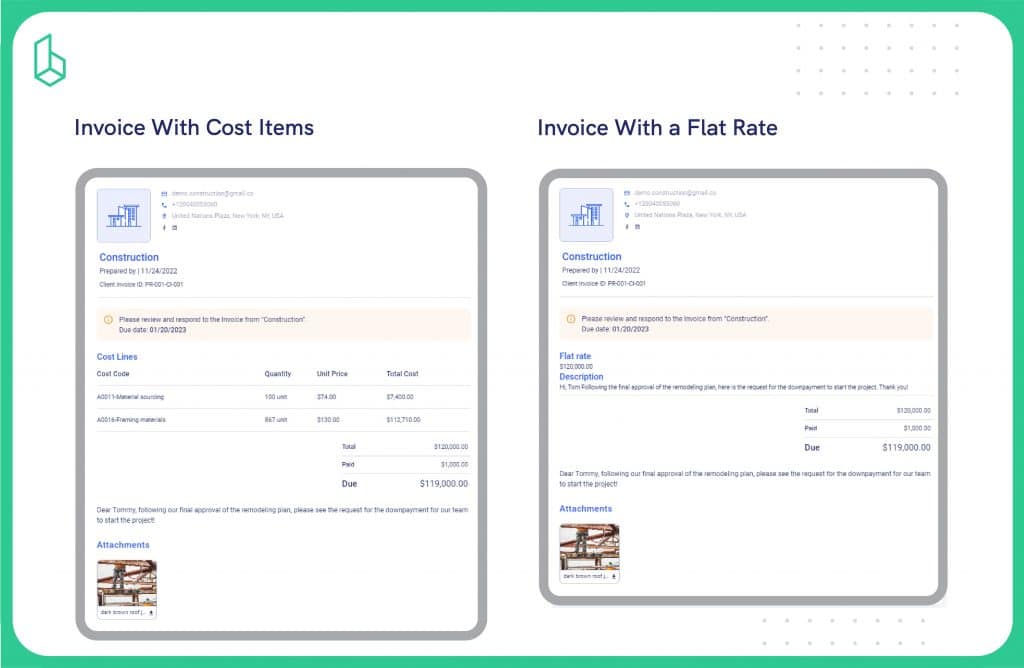
Step 3: Attach Files (optional)
This is an optional step, but it can make you look more professional and make it easier for the client to understand all the project details.
Attach any files related to the job, such as documents, photos, or videos. For example, an image with the room’s current state will show the client the progress and results you have achieved with your remodeling project.
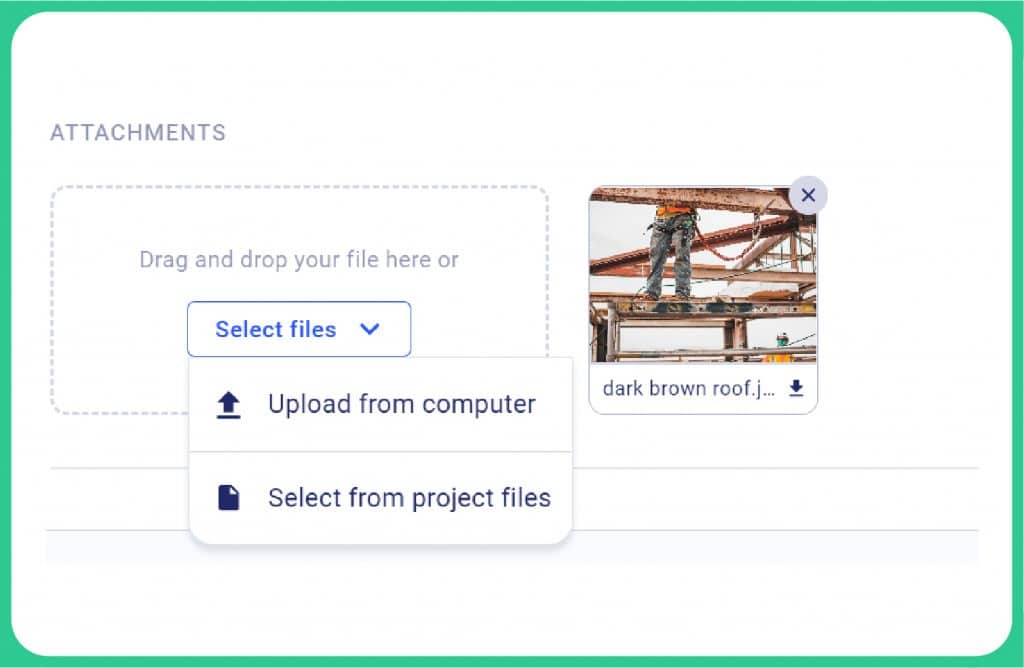
Step 4: Send the Invoice to the Client
Once done, you can send the invoice to your client from your Buildern account. Buildern will send the invoice to the client(s) you’ve chosen in step 1.
The client will instantly receive an email with the link to the invoice, with detailed notes on the invoice amount, due date, and other information about the job.
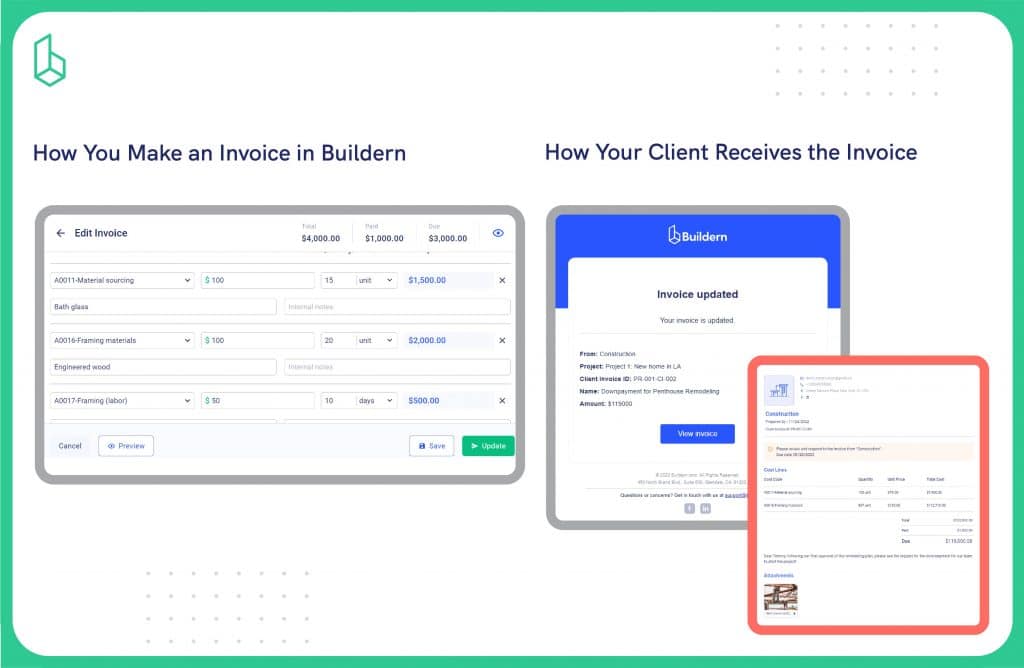
This way, you can ensure that your invoices arrive to the clients reliably and promptly. Meanwhile, all the information and documents related to the invoice are stored in your Buildern account.
Buildern will automatically change the invoice status to “viewed” once the client sees it.
Step 5: Track Invoices
All your construction invoices are carefully kept in your Buildern account, regardless of how many projects you have and how many invoices you send.
To manage your sent invoices, head back to “Client Invoices” on the left-side menu. Here you can see the list of all your invoices, filter them by status, sort by dates and search for a specific invoice or client.
Once you receive the payment for the specific invoice, record it inside that invoice by pressing “Record Payment” at the bottom of the page.
That way, you will have a clear picture of all your payments and their status: whether it’s been sent but not paid yet, or it’s already been paid.

Bonus Tip: Use Buildern’s integration with leading accounting software Xero or QuickBooks, to be ahead of the game. This way, you will not have to manually record your payments in both systems. Just connect Buildern with the chosen accounting software and have all the payments recorded and synched between the platforms automatically.
Read more on construction accounting, as well as on how you can integrate Buildern with Xero and Quickbooks.
8 Best Practices of Construction Invoicing to Get Paid on Time
Construction invoicing software is just one part of the process, and even though it makes invoicing way easier for contractors, there is still more to do to get paid on time.
Here are a few best practices that will help you get paid faster.
Send Invoices on Time
Sending invoices on time is one of the essential rules. And while it seems obvious, it’s still not always easy to follow for many construction companies. Invoices are usually sent late due to improper tracking of job completion, customer sign-off, etc.
And when the invoices are not sent on time, the payments are not received on time either. This, in turn, means the company’s cash flow can be disturbed, and the company will spend more resources than planned on late payments and collection processes.
So, make it a rule of thumb to agree with the client on exact invoicing dates depending on the job completion and follow the schedule.
Document Everything
The job completed in the jobsite by your team is nothing for your client until it’s properly documented and presented to the owner. Hence, ensure the project documentation is done correctly and shared with the client. This includes recording all the materials, labor hours and performed tasks that you want to get paid for.
Besides, a proper record of the project’s progress will help you send correct invoices without missing any details.
In this regard, it’s especially crucial to record change orders (when the client requests additional work). Change orders usually happen once the project is already in progress, which means that all additional needs should be recorded and invoiced separately.
Be Clear With Details
Invoices are formal requests for payment. Consequently, any error or misleading information in the invoice, such as wrong amount, incorrect dates, or unclear details, can cause payment delays. In the worst scenario, unclear invoices can become subjects of disputes.
So make sure that all the information is clear and accurate, including client’s name and address, invoice number, job and project details, and the cost of services provided.
Instruct the Client on How to Pay
Including payment instructions in the invoice is not a popular tactic, but it’s still worth mentioning. Sometimes, clients delay payments because they face difficulties with the payment process.
To avoid such issues, make sure that you provide clear instructions on how to pay the invoice. These include which payment method is accepted, what information is required and any other specific details.
Negotiate Possibly Short Payment Terms
Invoices are usually paid in 30-90 in the construction industry. However, giving the client the option of paying so late is not recommended. If you do your job with the right timing, you can send partial invoices with shorter terms.
The best way to do this is to divide the project into milestones and invoice according to each milestone. This will let you get paid faster and reduce the company’s working capital needs.
Have Late Pay Penalties
Sometimes, no matter what you do, the client might still delay paying the invoice. This issue is especially common with large organizations, which must go through approval processes before making the payment.
To be prepared for such cases, you can add a late penalty clause in your contract and invoice agreement. It will help ensure the client understands that missing payment deadlines means paying an additional fee.
An accepted practice is to charge a penalty fee of 1-3% every week the payment is late.
Have Early Pay Incentives
Well, if you discourage late payments, why not encourage early ones?
One way to do this is by offering your clients an early payment discount. For example, you can offer a few additional services to the client if they make the payment within 15-20 days. This can include warranty extensions or priority support for the project.
It’s a win-win situation – the client gets extra treatment, and you get paid faster.
Track Receivables Carefully | Adopt a Construction Invoicing Software
Last but not least, it’s essential to track all receivables carefully – you need to have a record of who owes what and when it should be paid. Otherwise, keeping track of payments and monitoring when they are due can be hard.
Construction invoicing software can be a great help in this situation. It’s designed to automate the entire invoicing process, from generating invoices to tracking payments and sending reminders about due amounts. It also provides detailed WIP reports on all receivables so that you can have an overview of your cash flow at any time and no invoice will ever be missed.

To Wrap up, Invoicing Is Only the Top of the Iceberg
To finalize, construction invoicing is only the tip of the iceberg regarding managing receivables in the construction industry.
Accurate invoicing results from the proper management of budgeting, quoting and scheduling of the construction project. So, you should not start from construction invoicing but from the entire project to have a successful invoice process and receive payments on time.
If you’re running a construction business, Buildern is a great platform to manage projects from start to finish. It provides everything you need to complete your project – from creating the budget and paying invoices to tracking payments and construction progress.
Instead of juggling different tools and processes and losing crucial data in between of that, carefully document and manage everything from one central platform.
Once you create a project in Buildern, you can smoothly manage all the rest:
- Create a project schedule and monitor the construction progress
- Estimate the costs, track expenses and generate invoices depending on the project’s completion
- Track change orders and adjust the project schedule and invoices correspondingly
If there is a robust system in place that connects all the project stakeholders and keeps contractors well-informed on every detail, there is less need to worry about late payments.
Your construction project will work as a well-oiled machine where everyone clearly understands their roles and responsibilities. This means no data is lost, construction delays are possibly minimized and most payments for the project are made on time.
So, look no further – Buildern is the ultimate construction project management platform that can transform your business!

